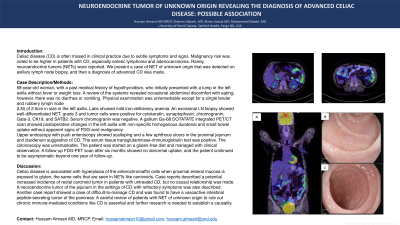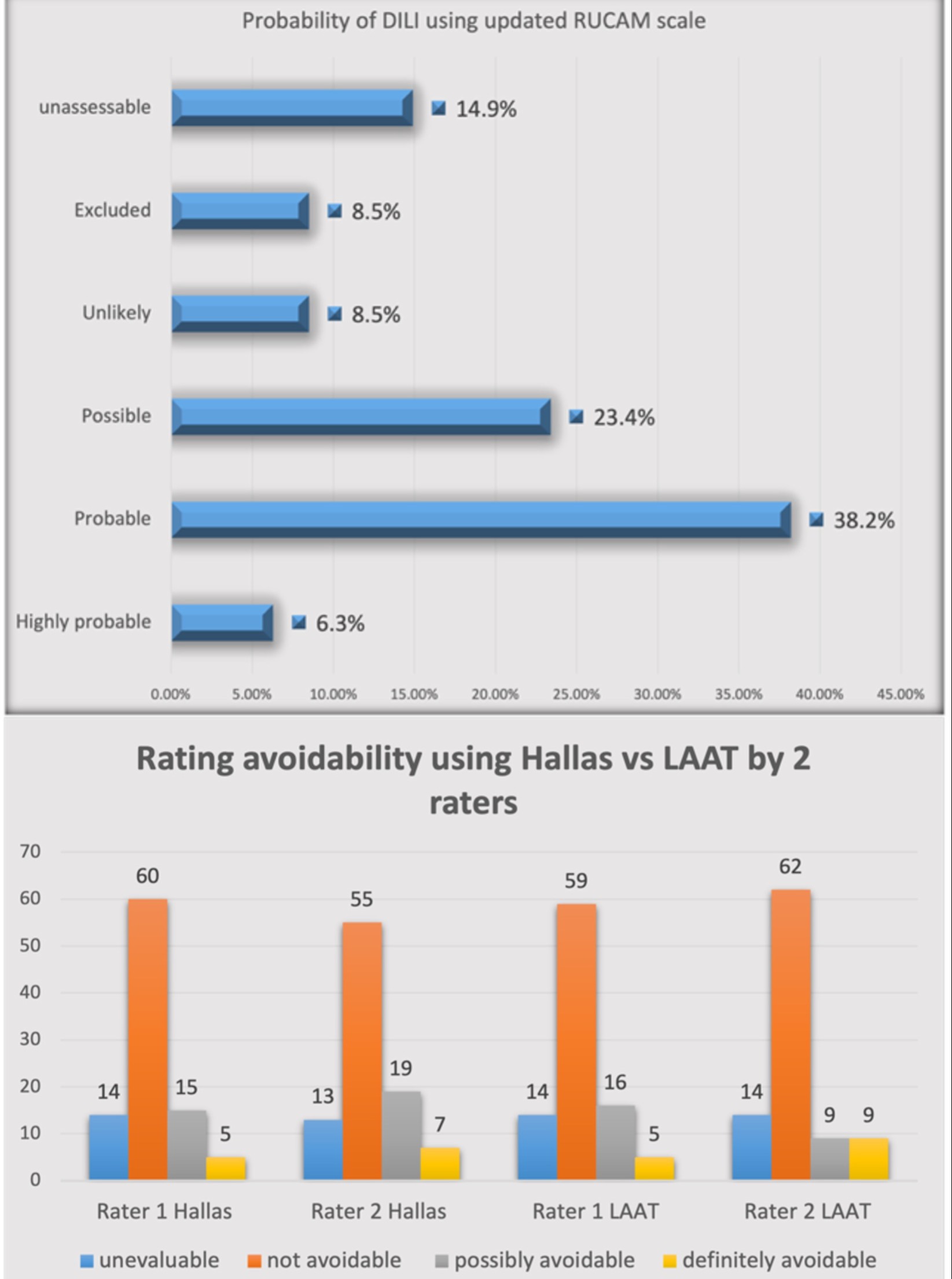Monday Poster Session
Category: Liver
P2903 - POSTER WITHDRAWN
Monday, October 28, 2024
10:30 AM - 4:00 PM ET
Location: Exhibit Hall E

Has Audio
Hussam Almasri, MD, MRCP1, Guneet Sidhu, MD1, Ibtihal Abdallah, PharmD2, Fadi Khir, MD2, Hadeel Alfar, MD2, Naim Battikh, MD2, Rita Ahmad, MD2, Alia Albattah, MD2, Mohammed Ibn-Mas’ud Danjuma, MD2
1University of North Dakota, Fargo, ND; 2Hamad Medical Corporation, Doha, Ad Dawhah, Qatar
Introduction: Drug-induced liver injury (DILI) poses a significant concern, especially for hospitalized patients when the cause of liver injury is considered an adverse effect of medication use. The prevalence and burden of DILI in this setting remain under-presented, necessitating the exploration of the preventability of DILI to guide therapeutic decision-making and intervention strategies. We aimed to assess the preventability of DILI in a diverse age group using the modified Hallas tool and the Liverpool adverse drug reactions avoidability tool (LAAT).
Methods: Retrospective analysis of electronic records of patients who were assessed for suspected DILI at Weill Cornell College of Medicine-affiliated Hamad General Hospital, Qatar, between February 2019 and January 2020. Patients aged 18 years and above were included. Clinical and demographic data were extracted, and DILI causality was assessed using the updated Roussel Uclaf Causality Assessment Method (RUCAM). Cases were evaluated for avoidability using modified Hallas and LAAT tools by six general physicians (i.e. 3 pairs). Inter-rater agreement and reliability were analyzed.
Results: Out of 94 cases, 47 (50%) were attributed to antimicrobials, with hepatocellular injury being the most common pattern. 42 (44.5%) were classified as "probable" or "highly probable" while 22 (23.4%) were categorized as possible DILI by the updated RUCAM scale (fig 1). Inter-class correlation for avoidability assessment was 0.7 (CI 0.57-0.78) for the modified Hallas and 0.61 (CI 0.6-0.8) for LAAT. The average pairwise percent agreement was 75% for Hallas and 77% for LAAT. "Not avoidable" was the most common outcome for both tools. “Definitely avoidable” outcome ranged between 5.5-9.5% (fig 2). Further rearranging the cases to assess only those categorized as "probable" and "highly probable", the ICC was 0.52 (95% CI 0.27-0.71) for Hallas and 0.56 (95% CI 0.31-0.73) for LAAT.
Discussion: This study sheds light on the preventability of DILI in hospitalized patients, indicating that a considerable proportion of DILI cases may be avoidable. The findings underscore the importance of systematic preventability assessments in guiding medication use decisions and interventions to mitigate the DILI burden, particularly in populations vulnerable to polypharmacy or severe illness. Despite limitations, such as the small sample size, this study contributes to the growing body of evidence supporting the utility of modified Hallas and LAAT tools in assessing DILI avoidability.

Disclosures:
Hussam Almasri, MD, MRCP1, Guneet Sidhu, MD1, Ibtihal Abdallah, PharmD2, Fadi Khir, MD2, Hadeel Alfar, MD2, Naim Battikh, MD2, Rita Ahmad, MD2, Alia Albattah, MD2, Mohammed Ibn-Mas’ud Danjuma, MD2. P2903 - POSTER WITHDRAWN, ACG 2024 Annual Scientific Meeting Abstracts. Philadelphia, PA: American College of Gastroenterology.
1University of North Dakota, Fargo, ND; 2Hamad Medical Corporation, Doha, Ad Dawhah, Qatar
Introduction: Drug-induced liver injury (DILI) poses a significant concern, especially for hospitalized patients when the cause of liver injury is considered an adverse effect of medication use. The prevalence and burden of DILI in this setting remain under-presented, necessitating the exploration of the preventability of DILI to guide therapeutic decision-making and intervention strategies. We aimed to assess the preventability of DILI in a diverse age group using the modified Hallas tool and the Liverpool adverse drug reactions avoidability tool (LAAT).
Methods: Retrospective analysis of electronic records of patients who were assessed for suspected DILI at Weill Cornell College of Medicine-affiliated Hamad General Hospital, Qatar, between February 2019 and January 2020. Patients aged 18 years and above were included. Clinical and demographic data were extracted, and DILI causality was assessed using the updated Roussel Uclaf Causality Assessment Method (RUCAM). Cases were evaluated for avoidability using modified Hallas and LAAT tools by six general physicians (i.e. 3 pairs). Inter-rater agreement and reliability were analyzed.
Results: Out of 94 cases, 47 (50%) were attributed to antimicrobials, with hepatocellular injury being the most common pattern. 42 (44.5%) were classified as "probable" or "highly probable" while 22 (23.4%) were categorized as possible DILI by the updated RUCAM scale (fig 1). Inter-class correlation for avoidability assessment was 0.7 (CI 0.57-0.78) for the modified Hallas and 0.61 (CI 0.6-0.8) for LAAT. The average pairwise percent agreement was 75% for Hallas and 77% for LAAT. "Not avoidable" was the most common outcome for both tools. “Definitely avoidable” outcome ranged between 5.5-9.5% (fig 2). Further rearranging the cases to assess only those categorized as "probable" and "highly probable", the ICC was 0.52 (95% CI 0.27-0.71) for Hallas and 0.56 (95% CI 0.31-0.73) for LAAT.
Discussion: This study sheds light on the preventability of DILI in hospitalized patients, indicating that a considerable proportion of DILI cases may be avoidable. The findings underscore the importance of systematic preventability assessments in guiding medication use decisions and interventions to mitigate the DILI burden, particularly in populations vulnerable to polypharmacy or severe illness. Despite limitations, such as the small sample size, this study contributes to the growing body of evidence supporting the utility of modified Hallas and LAAT tools in assessing DILI avoidability.

Figure: Figure 1 Probability of DILI using the Updated RUCAM scale among our cohort.
Figure 2 Hallas and LAAT outcome across pairs of raters.
Figure 2 Hallas and LAAT outcome across pairs of raters.
Disclosures:
Hussam Almasri indicated no relevant financial relationships.
Guneet Sidhu indicated no relevant financial relationships.
Ibtihal Abdallah indicated no relevant financial relationships.
Fadi Khir indicated no relevant financial relationships.
Hadeel Alfar indicated no relevant financial relationships.
Naim Battikh indicated no relevant financial relationships.
Rita Ahmad indicated no relevant financial relationships.
Alia Albattah indicated no relevant financial relationships.
Mohammed Ibn-Mas’ud Danjuma indicated no relevant financial relationships.
Hussam Almasri, MD, MRCP1, Guneet Sidhu, MD1, Ibtihal Abdallah, PharmD2, Fadi Khir, MD2, Hadeel Alfar, MD2, Naim Battikh, MD2, Rita Ahmad, MD2, Alia Albattah, MD2, Mohammed Ibn-Mas’ud Danjuma, MD2. P2903 - POSTER WITHDRAWN, ACG 2024 Annual Scientific Meeting Abstracts. Philadelphia, PA: American College of Gastroenterology.
